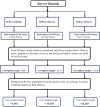Factors associated with unintended pregnancies in India among married women over the past one and half decade (2005-2021): a multivariable decomposition analysis
- PMID: 40200286
- PMCID: PMC11980145
- DOI: 10.1186/s12884-025-07524-0
Factors associated with unintended pregnancies in India among married women over the past one and half decade (2005-2021): a multivariable decomposition analysis
Abstract
Background: Along with other low- and middle-income countries unintended pregnancies are a matter of grave concern for India as well as world. Preventing unintended pregnancy can significantly reduce fertility as well as population health.
Methods: Our study used data from three recent rounds of national family health survey (NFHS) which were conducted in 2005-06 (NFHS-3), 2015-16 (NFHS-4) and 2019-21 (NFHS-5). In union, currently married and pregnant women who have given birth to at least one child in last five years were taken into consideration for study. Dependent variable was unintended pregnancy (current pregnancy) which included mistimed as well as unwanted pregnancy. Univariate, bivariate analysis with point-to-point change was done to know aboutdependent variable. To know about important covariate of change in unintended pregnancy logistic regression has been used followed by multivariable decomposition analysis.
Results: Over all three - survey rounds considered in our study; prevalence of unintended pregnancy declined from 31.76% (NFHS-3) to 15.87% (NFHS-5). Highest percentage decline of 23.02% from NFHS-3 (39.01%) to NFHS-5 (15.99%) in unintended pregnancy was in the women of Muslim religion. Women of rural area have 19% lower chance of unintended pregnancy with adjusted odds ratio 0.81. Odds of having current unintended pregnancy were about 8 times in women whose last birth was unwanted. Women with incorrect knowledge of ovulatory cycle have 20% higher chance of having unintended pregnancy. After analysis it was found that out of total change in unintended pregnancies was proximately 23% due to compositional change and about 77% change was due to behavioural change.
Conclusions: Over the time prevalence of unintended pregnancies declining which can be helpful for better health to both child and women. Important factors leading to a decline in unintended pregnancy were young age groups, high education level, unwanted last birth, no and negative fertility gap, no intention to contraceptive use and incorrect knowledge of the ovulatory cycle. Most of decline in unintended pregnancies was due to behavioural change of women considered in our study.
Keywords: Logistic regression; Multivariate decomposition analysis; NFHS; Unintended pregnancy.
© 2025. The Author(s).
Conflict of interest statement
Declarations. Ethical approval and consent to participate: Since our study was based on the secondary data which is freely available upon request in public domain so no ethical consideration was needed. Consent for publication: Not applicable. Competing interests: The authors declare no competing interests.
Figures
Similar articles
-
Level, Trend and Correlates of Mistimed and Unwanted Pregnancies among Currently Pregnant Ever Married Women in India.PLoS One. 2015 Dec 2;10(12):e0144400. doi: 10.1371/journal.pone.0144400. eCollection 2015. PLoS One. 2015. PMID: 26629813 Free PMC article.
-
Sexual violence as a predictor of unintended pregnancy among married women of India: evidence from the fourth round of the National Family Health Survey (2015-16).BMC Pregnancy Childbirth. 2022 Apr 21;22(1):347. doi: 10.1186/s12884-022-04673-4. BMC Pregnancy Childbirth. 2022. PMID: 35449041 Free PMC article.
-
Individual and contextual factors associated with mistimed and unwanted pregnancies among adolescent girls and young women in selected high fertility countries in sub-Saharan Africa: A multilevel mixed effects analysis.PLoS One. 2020 Oct 22;15(10):e0241050. doi: 10.1371/journal.pone.0241050. eCollection 2020. PLoS One. 2020. PMID: 33091050 Free PMC article.
-
Understanding U.S. fertility: continuity and change in the National Survey of Family Growth, 1988-1995.Fam Plann Perspect. 1996 Jan-Feb;28(1):4-12. Fam Plann Perspect. 1996. PMID: 8822409 Review.
-
Epidemiology of unintended pregnancy and contraceptive use.Am J Obstet Gynecol. 1994 May;170(5 Pt 2):1485-9. doi: 10.1016/s0002-9378(94)05008-8. Am J Obstet Gynecol. 1994. PMID: 8178895 Review.
References
-
- Marston C, Cleland J. Do unintended pregnancies carried to term lead to adverse outcomes for mother and child? An assessment in five developing countries. Popul Stud (NY). 2003;57(1):77–93. - PubMed
-
- Bongaarts J. Fertility and reproductive preferences in post-transitional societies. Popul Dev Rev. 2001;27(2):260–81. (Accessed on 2023 Aug 22). Available from https://www.jstor.org/stable/3115260
-
- United Nations Population Fund (UNFPA). State of the World Population: Seeing the unseen. The case for action in the neglected crisis of unintended pregnancy. UNFPA; 2022 accessed 27 August 2023. Available from https://www.unfpa.org/publications/seeing-the-unseen
MeSH terms
LinkOut - more resources
Full Text Sources
Miscellaneous



